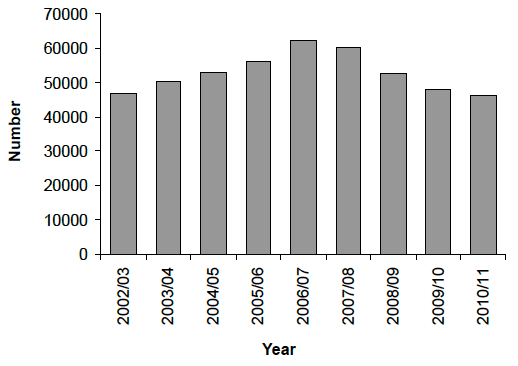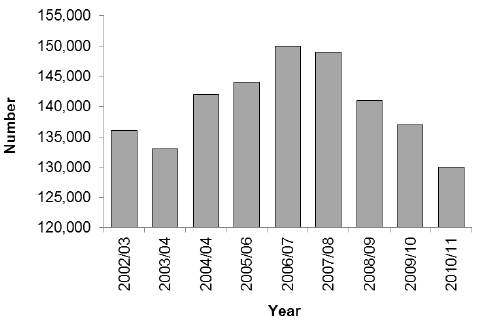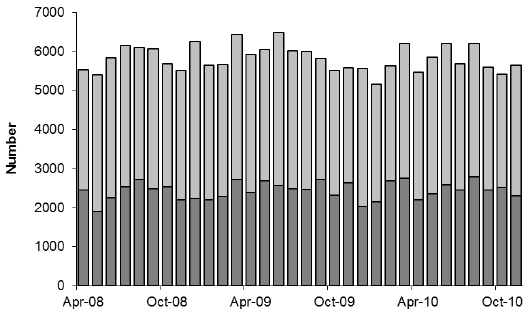Evaluation of the Impact of Bail Reforms on Summary Justice Reform
This report presents the findings from the Evaluation of the Impact of Bail Reforms on Summary Justice Reform. The research formed part of a wider package of work to evaluate Summary Justice Reform (SJR) in Scotland as a whole. The aim of the research was to evaluate how far the reforms to bail had met both their specific policy objectives as well as how far they had contributed to the overarching aims and objectives of SJR.
2 BAIL ORDERS AND USE OF SPECIAL CONDITIONS
2.1 Although the reforms to bail did not intend to impact on the frequency of its use, this chapter provides a summary of the extent to which bail is used in the criminal justice system in Scotland to provide context for the remainder of the report.
2.2 This chapter also explores the extent to which special conditions are used alongside bail and provides a summary of changes to the use of special bail conditions over time, post-reform.
Number of Bail Orders Granted
2.3 The Scottish Government publishes annual statistics on criminal proceedings concluded in Scottish courts, and data for the nine year period from 2002/03 to 2010/11 is shown in Figure 2.1 below. Table B.1 in Appendix B shows the raw data.
Figure 2.1 Bail Orders granted in Scotland

2.4 The 2010/118 publication showed that the total estimated number of bail orders granted by Scottish courts in 2010/11 was 46,221. This is the lowest number recorded in the nine year period and continues a year-on-year decrease since 2006/07.
2.5 This clear drop in the overall number of cases going to court mirrors a corresponding drop in the numbers of persons proceeded against in court, which was also at its lowest in 2010/11 since 2002/03, as shown in Figure 2.2 and Table B.2 in Appendix B.
Figure 2.2 Persons Proceeded Against in Court, 2002/03 to 2010/11

2.6 Although differences in the way that data is recorded means that it is not possible to say precisely whether the proportionate use of bail orders has varied over time, the data strongly indicates that the decrease in bail orders may simply reflect a corresponding drop in recorded crime and lower numbers of cases coming to court overall. The trends in the data therefore suggest that the proportionate use may be unchanged and this is not unexpected since the reforms to bail did not seek to impact on the frequency of bail per se.
Multiple Bail Orders
2.7 Scottish Government data also shows that the 46,211 bail orders granted in 2010/11 were issued to 33,713 individuals with:
- 77% of individuals receiving one bail order;
- 15% receiving two;
- 5% receiving three; and
- 3% receiving more than three.
2.8 This shows that the majority of bail recipients receive only one bail order in a year, with one in four having been released on bail on more than two occasions in the same year. This percentage has remained relatively steady over time, confirming the static level, pre and post-reform, of the judiciary granting bail to those who have already previously been released on bail. Again, this is not unexpected since the reforms sought primarily to strengthen existing law on bail in order to bring about increased transparency and improved consistency in bail decisions rather than affect its use. The data should also be considered in the context that alternatives to bail are limited - custodial remand is expensive and tends to be reserved for cases where public protection is a concern and releasing accused without bail conditions to await citation to appear may not always be appropriate.
Orders Awarded in Different Court Types
2.9 Table 2.1 shows the breakdown of bail orders granted at the national level by court type and covers the nine year period from 2002/03 to 2010/11 (thus showing both pre and post-reform data). Data is again taken from the Criminal Proceedings in Scotland 2010/11 publication.
Table 2.1 Bail Orders Made by Type of Court, National
| 02/03 | 03/04 | 04/05 | 05/06 | 06/07 | 07/08 | 08/09 | 09/10 | 10/11 | |
|---|---|---|---|---|---|---|---|---|---|
| All Courts | 46,795 100% |
50,155 100% |
52,820 100% |
56,233 100% |
62,283 100% |
60,355 100% |
52,592 100% |
47,921 100% |
46,221 100% |
| High | 226 0% |
359 1% |
345 1% |
294 1% |
434 1% |
305 1% |
279 1% |
261 1% |
252 1% |
| Sheriff | 41,379 88% |
43,273 86% |
46,757 89% |
50.272 89% |
55,443 89% |
54,089 90% |
47,545 90% |
43,133 90% |
41,710 90% |
| District/JP | 5,190 11% |
6,523 13% |
5,709 11% |
5,647 10% |
6,400 10% |
5,958 10% |
4,767 9% |
4,522 9% |
4,256 9% |
2.10 Historically, most bail orders are granted by Sheriff courts with JP courts (previously District courts) and the High court granting the remainder. This reflects the relative business volumes dealt with by these courts, with fewer orders being issued by the High court since they deal with only a small proportion of cases and the most serious offences, some of which will also be least suitable for bail. Sheriff court orders typically account for around 90% of all orders granted and the data shows that there has been little variation in the proportionate use of bail orders between court jurisdictions over time.
Crime Types
2.11 National statistics are available to show the bail orders made against the main charge for which the accused first appeared at court9. This data shows that, over time, the main offences for which bail orders have been granted are crimes of dishonesty, common assault and breach of the peace. The data show that there has been no real change in the types of charge for which orders are granted post-reform which is perhaps not surprising, since this was not something that the reforms sought to change.
Bail Orders with Special Conditions
2.12 In addition to the standard conditions of bail set out in Chapter 1, a number of 'special conditions' may be attached to a bail order at the time it is granted. These may include, for example, restrictions on where an accused can go or a home curfew. Although data is not currently available from the Scottish Court Service or other organisations on the different types of special conditions awarded, Figure 2.3 shows the aggregate number of bail order cases nationally where special conditions were attached to the bail order. The raw data is shown in Appendix B, Table B.3.
Figure 2.3 Number of Bail Orders with and without Special Conditions

2.13 The data show that, in the 32 month period from April 2008 to November 2010, on average, just over half of all bail orders had special conditions attached. The average across the period was 58% and there was little variance in this distribution over the three year period post-reform. The proportionate use of special conditions does not seem to be affected by the overall drop in bail orders being awarded overall. The lack of pre-reform data also means that it is not possible to say if there was an immediate impact of the reforms on use of special conditions.
2.14 Interestingly, qualitative data from professional interviewees suggests that they perceived an increase in the number of special conditions attached to orders in recent years:
"I think that what has happened is that there are more conditions being attached to bail than ever there were in the past…I think that it's the same people that were always getting bail, and still getting bail, but with more conditions, like curfews, and things. [Defence Agent]
"I think there have been more special conditions, especially in relation to domestic violence, I can't think of a case there where there hasn't been a special condition added". [Procurator Fiscal]
2.15 Procurators Fiscal in particular noted the increase in the use of special conditions post-reform, with courts using conditions for a wider set of offences. These Procurators Fiscal could see the benefit in special conditions and welcomed their use:
"I think that the special conditions can be very useful in making it absolutely clear to people what the score is. I think it's a useful tool so people are reminded what their responsibilities are". [Procurator Fiscal]
Summary
2.16 Overall, the context data shows that there has been a reduction in the number of bail orders granted by the courts which mirrors a wider reduction in the court caseloads per se. Although it is not possible to say conclusively if the proportionate use of bail orders has changed post-reform, the trends in the numbers of persons prosecuted in courts and in the use of bail orders suggest that there has not been a notable change.
2.17 Although the data do not tell us anything conclusive about the use of special conditions pre and post-reform, interview data does suggest that the judiciary may be making noticeably more use of special conditions over time, and this is something that Procurators Fiscal seemed to welcome.
2.18 Having set the context of the evaluation, in terms of the use of bail and special conditions, the remainder of the report explores the extent to which the main policy objectives for the bail reforms have been met as well as their overlap with wider SJR objectives.
Contact
Email: Carole Wilson
There is a problem
Thanks for your feedback